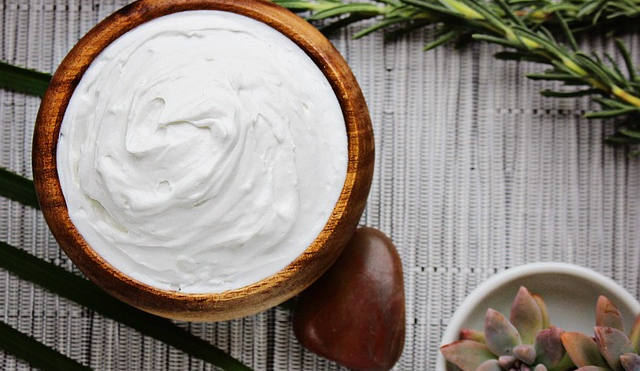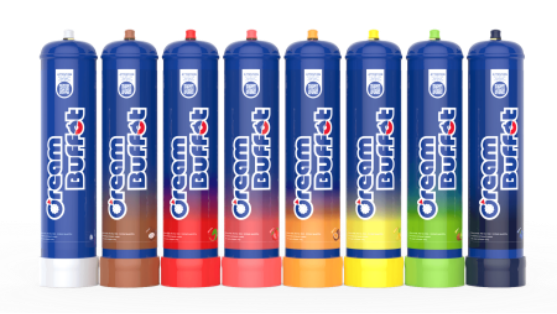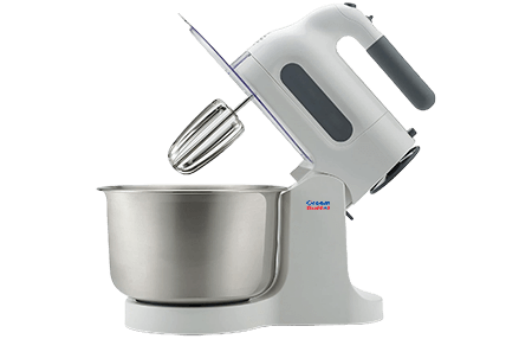We know that whipped cream is the key to enhancing the taste in cooking. It can breathe new life into desserts and beverages, bringing a more diverse range of flavors and layers. However, achieving the ideal texture of whipped cream is often a challenging process, and one common and frustrating problem is having whipped cream that is too thin.
First, ensure that you use cold cream. The whipping tools and cream charger should also be pre – cooled to maintain the stability of the cream. When using a cream charger, make sure the ratio of gas to cream is correct to avoid using too much cream. Second, stabilizers such as gelatin, cream of tartar, or powdered sugar can be used to enhance the structure and stability of the cream. By following these methods, you can effectively prevent whipped cream from being too thin.
Next, we will not only analyze in detail the methods to solve the problem of overly thin whipped cream but also explore the role of cream chargers and other key factors.

1.The Importance of Whipped Cream in Cooking
1.1 The Diverse Uses of Whipped Cream in Desserts and Beverages
Whipped cream is far more than just a simple decoration; it is a versatile ingredient that significantly contributes to the overall sensory experience of a dish. In the realm of desserts, it adds a luxurious and rich element to the richness of a chocolate cake or the tart – sweetness of a lemon meringue pie. For beverages, it provides a smooth, velvety contrast to the bitterness of coffee or the spiciness of flavored cocoa. Its ability to blend with different flavors and textures makes it an essential component in both sweet and savory culinary creations.
1.2 Understanding the Problem of Overly Thin Whipped Cream
Although it may seem simple, achieving the ideal texture of whipped cream remains a challenge for many. Overly thin whipped cream not only spoils the visual appeal of a dish but also undermines the balance of its texture and flavor. It fails to provide the required richness and stability, resulting in a less – than – satisfactory eating experience. Understanding the root causes of overly thin whipped cream is crucial for finding effective solutions.
1.3 How Cream Chargers Revolutionize the Whipped Cream – Making Process
Cream chargers are small cylinders filled with nitrous oxide (N₂O) that have revolutionized the way whipped cream is made. They offer a precise and efficient method of aerating cream, ensuring consistent and high – quality results. When a cream charger is used in a cream whipper, the nitrous oxide gas is released into the cream, creating a fine – textured foam. This process is faster and more reliable than traditional whipping methods, making it popular among both professional chefs and home cooks.
2.How Overly Thin Whipped Cream Affects Your Dishes
2.1 The Visual and Sensory Impact of Overly Thin Whipped Cream
Overly thin whipped cream has a profound impact on the presentation and taste of a dish. Visually, it gives the impression of an ill – prepared or unappealing dessert or beverage. Instead of forming a neat, fluffy topping, overly thin whipped cream runs haphazardly, ruining the overall aesthetics. From a sensory perspective, it lacks the firmness and structure needed to provide a satisfying mouthfeel. Properly whipped cream should offer a slight resistance when bitten or sipped, followed by a smooth, rich, melt – in – the – mouth sensation. Overly thin whipped cream, however, feels watery and thin, reducing the overall enjoyment of the dish.
2.2 The Commercial Impact of Overly Thin Whipped Cream in the Foodservice Industry
In the commercial foodservice sector, the quality of whipped cream can be a critical factor in determining customer satisfaction and, ultimately, the success of a business. Customers expect a certain quality standard, and overly thin whipped cream can lead to disappointment and negative reviews. For bakeries, cafes, and restaurants, consistently providing high – quality whipped cream is essential for building a loyal customer base. It also affects word – of – mouth recommendations, which are crucial for attracting new customers.
2.3 The Importance of High – Quality Tools for Making Perfect Whipped Cream
In the pursuit of perfect whipped cream, using reliable tools is essential. High – quality cream chargers ensure a stable and accurate release of nitrous oxide gas. This, in turn, allows the cream to be aerated more evenly, resulting in stable and well – textured whipped cream. Additionally, other tools such as high – quality cream whippers, bowls, and whisks play a vital role in the whipping process. Each piece of equipment must be in optimal condition to achieve the best results.

3.How Cream Chargers Solve the Problem of Overly Thin Whipped Cream
3.1 How Cream Chargers Create the Perfect Texture
Cream chargers work on the principle of gas – induced aeration. When a cream charger is inserted into a compatible cream whipper and the valve is activated, nitrous oxide gas is released into the cream. Nitrous oxide is soluble in cream, and as it diffuses through the liquid, it forms tiny bubbles. These bubbles expand the volume of the cream, creating the characteristic light and fluffy texture of whipped cream. The solubility of nitrous oxide in cream also helps to stabilize the foam, preventing it from collapsing quickly.
3.2 The Benefits of Using Cream Chargers to Make Stable Whipped Cream
- Consistency: Cream chargers offer a high degree of consistency in the whipped – cream – making process. Since the amount of gas released is relatively uniform, each batch of whipped cream made with the same amount of cream and a properly functioning charger will have a similar texture.
- Efficiency: Using cream chargers significantly reduces the time and effort required to whip cream. In a professional kitchen environment, this is a major advantage, enabling faster service and increased productivity.
- Precision: Cream chargers allow users to precisely control the aeration process. By following the manufacturer’s guidelines regarding the amount of cream per charger, users can achieve the desired thickness and fluffiness in their whipped cream.
3.3 How to Choose the Right Cream Charger
- Quality Standards: It is crucial to choose cream chargers that meet high – quality standards. Look for chargers made of durable materials and designed to prevent leaks. Chargers known for their purity ensure that no contaminants enter the cream, which could affect its taste and texture.
- Brand Reputation: Well – known brands typically invest in research and development to improve the performance of their cream chargers. For example, Cream Buffet continuously tests and improves its cream chargers, which have eventually been recognized by the market.
- Compatibility: Ensure that the cream charger you choose is compatible with your cream whipper. Different whippers may have specific requirements for the size and shape of the charger. Using an incompatible charger may result in inefficient gas release or even damage to the whipper.
4.Key Strategies for Solving the Problem of Overly Thin Whipped Cream
4.1 The Impact of Cold Cream on the Texture of Whipped Cream
Temperature has a profound impact on the stability and texture of whipped cream. Cream contains fat globules, and when whipped, these fat globules come together, trapping air bubbles in the process. Cold temperatures help to solidify the fat in the cream, making it easier for the fat globules to form a stable network around the air bubbles. On the other hand, warm cream has a higher risk of the fat globules melting or not aggregating properly, resulting in a too – thin texture.
Pre – cooling Techniques for Making Perfect Whipped Cream:
- For Cream Chargers: Before using a cream charger, pre – cool the cream, the cream whipper, and the charger itself. Place the cream in the refrigerator for at least an hour to ensure it is completely cold. The whipper and charger can be placed in the freezer for 30 minutes. This pre – cooling process helps to maintain a low temperature during whipping, which is crucial for making stable whipped cream.
- Traditional Whipping Methods: When using traditional whipping methods, place the bowl and whisk (or the attachment of an electric mixer) in the freezer for 15 – 20 minutes. The cold equipment helps to keep the cream cold while whipping, facilitating better air incorporation and the formation of a more stable foam.
4.2 The Appropriate Gas – to – Cream Ratio for Making Perfect Whipped Cream
4.2.1 How to Find the Ideal Gas – to – Cream Ratio
The ratio of gas to cream is a key factor in achieving the ideal texture of whipped cream. When using a cream charger, it is crucial to follow the manufacturer – recommended ratio. Generally, a standard cream charger is suitable for up to 500 ml of cream. However, this may vary depending on the specific charger and the desired texture. If the whipped cream turns out too thin, it may indicate that there is too much cream relative to the amount of gas, and vice versa if it is too thick.
4.2.2 Adjusting the Gas – to – Cream Ratio According to the Desired Texture
- For Cream Chargers: If the whipped cream is too thin, you can try reducing the amount of cream in the whipper or using a larger – sized charger if available. Conversely, if the whipped cream is too thick, you may need to add more cream or use a smaller – sized charger.
- Traditional Whipping Methods: When whipping cream by hand or with an electric mixer, the key is to stop whipping at the right stage. The soft – peak stage is reached when the cream holds its shape but still bends slightly when the whisk is lifted. The stiff – peak stage is when the cream stands upright firmly. Over – whipping can cause the cream to become thin as the fat globules break down and the structure collapses. If the cream is over – whipped, you can try gently folding in a small amount of cold cream to restore the proper texture.
4.3 Using Stabilizers to Solve the Problem of Overly Thin Whipped Cream
4.3.1 Top Stabilizers for Thickening Whipped Cream
- Gelatin: Gelatin is a protein – based stabilizer that can be used to enhance the firmness and stability of whipped cream. It works by forming a network of chains that trap air bubbles. Gelatin must first be fully dissolved in warm water before being added to the cream. Once added, it helps the whipped cream to hold its shape for a longer time, even at slightly higher temperatures.
- Cream of Tartar: Cream of tartar is an acidic powder that can be added to whipped cream to help it reach stiff peaks more quickly and maintain stability. It works by adjusting the pH of the cream, which affects how the proteins in the cream interact. Adding a small amount of cream of tartar (about 1/8 to 1/4 teaspoon per cup of cream) can have a significant impact on the texture of the whipped cream.
- Powdered Sugar: Powdered sugar not only sweetens whipped cream but also acts as a stabilizer to some extent. The fine particles of powdered sugar help to coat the air bubbles in the whipped cream, providing more structure and stability. Using powdered sugar instead of granulated sugar results in a smoother and more stable whipped cream.
4.3.2 How to Incorporate Stabilizers into Whipped Cream
- When Using Cream Chargers: When using cream chargers, dissolve the gelatin in water according to the package instructions and let it cool to lukewarm. Then, add it to the cream before inserting the charger into the whipper. If using powdered sugar, mix it thoroughly with the cream before aeration.
- Traditional Whipping Methods: For traditional whipping methods, gradually add the stabilizers during the whipping process. When using gelatin, add it slowly as the cream starts to thicken. When using cream of tartar, sift it in at the start of whipping. When the cream reaches the soft – peak stage, you can add powdered sugar in small increments.
4.4 Troubleshooting for Solving the Problem of Overly Thin Whipped Cream
4.4.1 Using Cream Chargers to Solve the Problem of Overly Thin Whipped Cream
- Overly Thin Whipped Cream: If the whipped cream is too thin after using a cream charger, first check if the whipper was properly refrigerated before use. If not, place the filled whipper in the refrigerator or freezer for a few minutes to harden the cream. Also, ensure that the charger is fully inserted and the gas has been released correctly. If the problem persists, you may need to adjust the gas – to – cream ratio as described above.
- Overly Thick or Grainy Whipped Cream: If the whipped cream is overly thick or grainy, it may be due to too much gas or over – whipping. Try adding a small amount of cold cream to the whipper and gently shaking it to loosen the texture. If the problem is with gas release, ensure that the charger is not defective and that the amount of cream you are using is appropriate for the charger size.
4.4.2 Troubleshooting for Overly Thin or Over – Whipped Whipped Cream in Traditional Methods
- Overly Thin Whipped Cream: If the cream is too thin after traditional whipping, you can try whipping it a little more gently for a while. Sometimes, the cream may not have been aerated enough. However, be careful not to over – whip. If it has already been over – whipped, you can add a small amount of cold cream and gently fold it in an attempt to salvage the texture.
- Over – Whipped Cream: If the cream is over – whipped and starts to separate, it can be more challenging to fix. One option is to add a small amount of high – fat cream and try to mix it gently. Another method is to strain the separated cream through cheesecloth, remove the liquid, and then re – whip the remaining solid part with a small amount of fresh cream.

5.How to Prevent Overly Thin Whipped Cream in the Future
5.1 Best Practices for Storing and Handling Whipped Cream
5.1.1 How to Ensure the Integrity of Cream Chargers
- Inspection: Before each use, carefully inspect the cream charger for any signs of damage, such as dents, cracks, or rust. A damaged charger may not release gas correctly, resulting in inconsistent or overly thin whipped – cream texture.
- Storage: Store cream chargers in a cool, dry place, away from direct sunlight and heat sources. Extreme temperatures can affect the integrity of the charger and the performance of the gas.
- Expiry Date: Pay attention to the expiry date on the cream charger. Using an expired charger may result in reduced gas pressure and poor – quality whipped cream.
5.1.2 Best Practices for Storing Cream and Equipment
- Cream Storage: Place the cream in the coldest part of the refrigerator, usually the back or bottom shelf. Cream should be stored at a temperature between 32°F and 40°F (0°C and 4°C). Avoid storing cream near the refrigerator door as the temperature in this area fluctuates more.
- Equipment Pre – cooling: As mentioned before, pre – cool all equipment, including bowls, whisks, and cream whippers, before use. This helps to maintain a low temperature during the whipping process, which is crucial for making stable whipped cream.
5.1.3 Maintaining Cleanliness and Hygiene in the Whipped – Cream – Making Process
- Equipment Cleaning: Ensure that all equipment used in the whipping process is thoroughly cleaned and dried. Residue from previous use, especially any traces of water or other liquids, can interfere with the whipping process and cause the cream to become thin. Wash the bowls, whisks, and whippers with hot, soapy water and rinse them thoroughly. Dry them completely before use.
- Hands and Workspace: Keep your hands clean and the workspace tidy when preparing to whip cream. Any contaminants, such as dust or bacteria, can affect the quality of the cream and its ability to hold its shape.
5.1.4 Proper Storage of Whipped Cream after Preparation
- Sealed Container: After whipping the cream, store it in a sealed container in the refrigerator. Exposure to air can cause the whipped cream to lose volume and become thin over time. A sealed container helps to maintain the freshness and texture of the whipped cream.
- Storage Duration: Whipped cream should be consumed within 1 – 2 days after preparation. Over time, even when properly stored in the refrigerator, the structure of the whipped cream will break down.
5.2 Choosing High – Quality Ingredients and Tools for Making Perfect Whipped Cream
5.2.1 How to Select the Best Whipping Cream
- Fat Content: Choose high – fat cream or heavy – whipping cream with a fat content of at least 36% – 38%. Cream with a higher fat content contains more fat globules, which are crucial for making stable and rich whipped cream. Cream with a lower fat content may not whip well and is more likely to result in a too – thin texture.
- Freshness: Always use fresh cream. Check the expiration date on the packaging before purchasing and try to use it within a few days of opening. Fresh cream has a better flavor and is more likely to whip into the desired texture.
5.2.2 Why High – Quality Cream Chargers Are Important
- Purity and Performance: High – quality cream chargers are made of materials that ensure the purity of nitrous oxide gas. They also have a stable and reliable gas – release mechanism. Investing in high – quality chargers will result in better – quality whipped cream, reducing the problems of overly thin or inconsistent texture.
- Safety Features: Look for cream chargers with safety features such as a secure seal and a mechanism to prevent accidental gas release. This not only ensures the quality of the whipped cream but also protects the user from potential hazards.
5.2.3 Maintaining and Selecting the Best Whipping Equipment
- Regular Maintenance: If using a cream whipper, conduct regular maintenance checks. This includes checking the seals for any signs of wear or damage, cleaning the nozzle to prevent clogs, and ensuring that the valve of the whipper is working properly. For electric mixers, check the beaters for signs of bending or damage and ensure that the motor is running smoothly.
- Equipment Quality: Invest in high – quality whipping equipment. A good – quality bowl and whisk or a reliable electric mixer can make a significant difference in the whipping process. High – quality bowls are usually made of materials with good thermal conductivity, which helps to keep the cream cold during whipping. Whisks and beaters with the right shape and design can also incorporate air more effectively.

6.Conclusion
Achieving the ideal texture of whipped cream is a combination of science, technology, and the proper use of tools and ingredients. By understanding the complex interplay of factors such as temperature, gas – to – cream ratio, and the role of stabilizers, and by implementing appropriate storage and handling methods, you can overcome the common problem of overly thin whipped cream.
Whether you are a professional chef looking to perfect your dessert offerings or a home cook aiming to enhance your culinary creativity, you can’t go wrong with choosing Cream Buffet‘s cream chargers. Feel free to consult us!